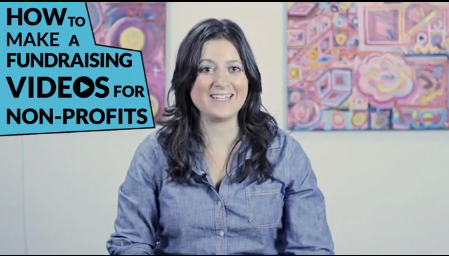Hub LA Shares: 10 Steps to Making a Great Fundraising Video
For our blog series “Hub LA Shares,” we’ve asked our members to share their expertise on something they’re passionate about professionally or personally. In this post, Steph Belsky of Lucid and Mike Tringe of CreatorUp joined forces to give us some pointers on how to make an effective fundraising videos. Perfect for nonprofits about to make their annual appeal or anyone looking to start a crowdfunded campaign, their “share” embodies the fantastic results of a Hub LA collaboration. This post originally appeared on CreatorUp’s website. Steph and Mike are leading workshops at Hub LA on Saturdays November 16 and November 23. Register for a workshop. They’re fun, useful, and full of treats.
If you work with or for a non-profit, the organization likely has a powerful mission that you believe in. So how can you share the story of that mission in a video that everyone can relate to, aiding in your fundraising efforts? (Perk alert! Free video tutorial course inside.)
This ten-step guide will help you explore the fundraising ideas nonprofits often shy away from – because a fundraising video seems out of reach. We’ve included a coupon for a free CreatorUp full 80 minute video tutorial course on “How to Develop a Fundraising Video for Non-Profits” at the end to give you a step by step action plan to develop the script for your first video.
1. Give people a reason to care.
Video is an emotional medium. Take advantage of the power or video to tell your organization’s story by understanding how it works best.
2. Share your story first.
Don’t ask for money right away – build it into your story at the right time. Don’t start out your video asking for something before you’ve given anything to your audience that they can actually relate to.
3. Be clear about your story.
Boil it down to one or two lines so that it can be efficiently communicated to a larger audience in a short amount of time. Video is a fast moving medium, and people will click away the moment the rambling begins.
4. Know your audience.
Telling a story to your target audience is different than trying to tell the entire world – first, focus on communicating to your niche so that you can gain a foundation of support with your most loyal followers.
5. Utilize the resources in front of you.
It’s easy to use the excuse that “we don’t have the resources” to make a video – but in reality, you likely have a camera phone in your pocket, or a friend that owns a DSLR camera, and the editing software is free with online solutions like WeVideo.
6. Write your script out.
It doesn’t need to take you longer than an hour to do, and on the back end, it will save you days in editing. A script is the blueprint to your video, and without it, you’re going to be wasting a lot of time shooting video that you’ll have to sort through later.
7. Capture your audience right away.
You don’t have time to waste when getting your audience engaged – in fact, you have about 5 seconds or less. If audiences aren’t interested in what you’re showing them in five seconds, they won’t stick around to see the rest.
8. Engage your audience with people.
Audiences need a reason to keep watching. This means, your story should have points of interest that keep us wanting to know more. Often times the simplest way to engage people is to make it personal – so be sure that you’re showing the people in your organization’s story and how they help you fulfill your mission.
9. Choose powerful images.
If you were writing an article or a book, you would choose your words carefully. Similarly, when making a video, you should have a clear idea of what images you want to show that will help compel your target audience to help you fundraise.
10. Create a strong call to action.
At the end of sharing your organization’s story in the video, be sure that you have a clear call to action that asks for a reasonable amount to help you with your fundraising efforts. If your target audience feels that you’re asking too much – they may be unlikely to want to give anything at all.
If you enjoyed this blog post, you may enjoy taking Steph’s video tutorial course “How to Develop a Fundraising Video.” Steph has made the course available to everyone at no cost using this coupon code: CU_NONPROFIT_VIDEO.
Mike Tringe is the founder of CreatorUp, an online web series school where creators can learn to make new projects. He earned his MFA in Film Production from USC and has worked at Creative Artists Agency Film Sales (Paranormal Activity, Black Swan), Vuguru, Michael Eisner’s multi-platform studio, (The Booth at the End (Hulu), Don’t Ask, Don’t Tell (Snag), Little Women Big Cars (AOL), and Blip Networks (300 million monthly views, Smosh, Annoying Orange, Nostalgia Critic).
Stephanie Belsky is the founder of Lucid, a video content strategy consultancy for non-profits. Steph founded the marketing department at College Humor and has worked with companies like YouTube network BigFrame and non-profits like the Global Woman’s Empowerment Network. Fundraising ideas nonprofits that utilize video are incredibly powerful, and Steph is leading the way to help organizations make the most of this incredible opportunity.
Register for Steph and Mike’s workshop!
Learn more about becoming a member of Hub LA so you can be a part of collaborations like Steph and Mike’s.
Leave a Response
November 14th, 2013
Posted by Hub LA
Tags: crowdfund, fundraising, Hub LA, impactpro, members, nonprofit, shares, startup, techforchange, video
Events, High Impact Angelenos, Member Shares, Profiles, Resources, Socent News, The Hub LA
